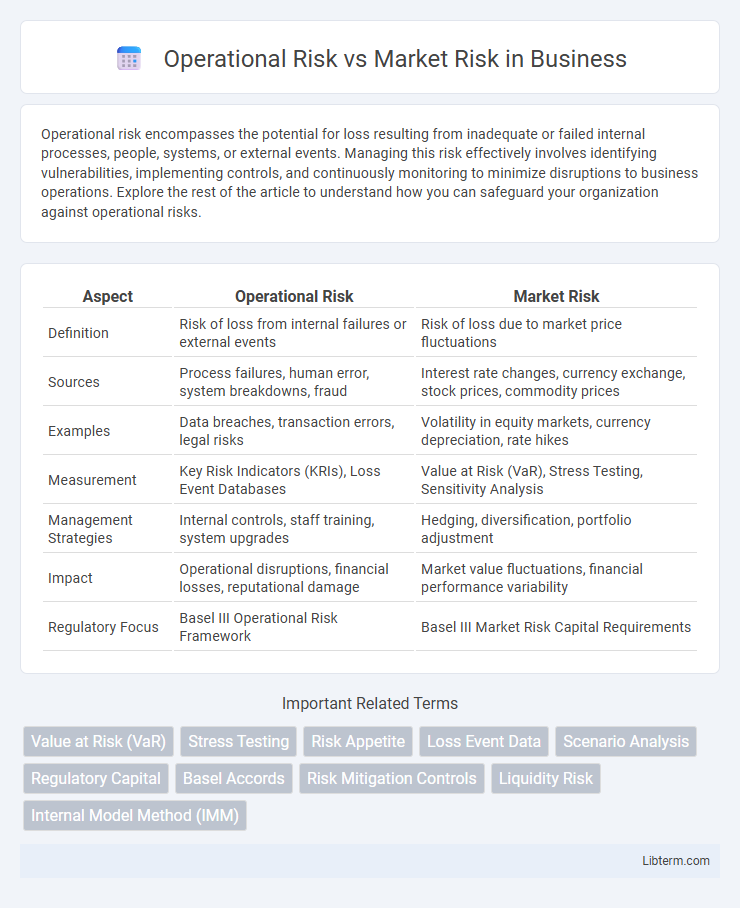Operational risk encompasses the potential for loss resulting from inadequate or failed internal processes, people, systems, or external events. Managing this risk effectively involves identifying vulnerabilities, implementing controls, and continuously monitoring to minimize disruptions to business operations. Explore the rest of the article to understand how you can safeguard your organization against operational risks.
Table of Comparison
| Aspect | Operational Risk | Market Risk |
|---|---|---|
| Definition | Risk of loss from internal failures or external events | Risk of loss due to market price fluctuations |
| Sources | Process failures, human error, system breakdowns, fraud | Interest rate changes, currency exchange, stock prices, commodity prices |
| Examples | Data breaches, transaction errors, legal risks | Volatility in equity markets, currency depreciation, rate hikes |
| Measurement | Key Risk Indicators (KRIs), Loss Event Databases | Value at Risk (VaR), Stress Testing, Sensitivity Analysis |
| Management Strategies | Internal controls, staff training, system upgrades | Hedging, diversification, portfolio adjustment |
| Impact | Operational disruptions, financial losses, reputational damage | Market value fluctuations, financial performance variability |
| Regulatory Focus | Basel III Operational Risk Framework | Basel III Market Risk Capital Requirements |
Introduction to Operational and Market Risk
Operational risk involves potential losses from internal failures such as system breakdowns, human errors, or fraud, directly impacting business processes and organizational resilience. Market risk refers to the exposure to financial losses resulting from fluctuations in market prices, including interest rates, currency exchange rates, and equity prices. Both risks require robust identification, measurement, and mitigation strategies to protect financial institutions and corporate entities from unexpected adverse events.
Defining Operational Risk
Operational risk refers to the potential for loss resulting from inadequate or failed internal processes, people, systems, or external events. It encompasses risks such as fraud, system failures, human errors, and legal risks, distinguishing it from market risk, which involves losses due to fluctuations in market prices and rates. Effective management of operational risk requires robust internal controls, risk assessments, and continuous monitoring to mitigate potential disruptions in business operations.
Defining Market Risk
Market risk refers to the potential financial loss resulting from fluctuations in market prices, such as equity prices, interest rates, foreign exchange rates, and commodity prices. It arises due to changes in the overall market environment affecting the valuation of investments and trading portfolios. Unlike operational risk, which stems from internal failures like system breakdowns or fraud, market risk is primarily driven by external market forces and economic conditions.
Key Differences Between Operational and Market Risk
Operational risk stems from internal failures such as system breakdowns, human errors, or fraud, whereas market risk arises from fluctuations in market variables like interest rates, stock prices, and exchange rates. Operational risk is largely influenced by organizational processes and controls, while market risk depends on external economic and financial conditions. Measuring operational risk often involves scenario analysis and loss data, contrasting with market risk's reliance on quantitative models such as Value at Risk (VaR) and stress testing.
Sources of Operational Risk
Operational risk originates from internal failures such as system breakdowns, human errors, and fraud, contrasting with market risk which stems from external market fluctuations like interest rate changes and stock price volatility. Key sources of operational risk include inadequate internal processes, technology failures, and compliance breaches. Identifying and mitigating these operational vulnerabilities is essential for maintaining financial stability and preventing unexpected losses.
Sources of Market Risk
Market risk originates from fluctuations in asset prices, interest rates, currency exchange rates, and commodity prices that directly impact financial portfolios. Major sources include equity price volatility, interest rate shifts affecting bond valuations, currency exchange rate changes caused by geopolitical events, and commodity price swings driven by supply-demand dynamics. Unlike operational risk, which stems from internal failures or external disruptions, market risk is primarily linked to external market forces beyond the control of individual institutions.
Impact on Financial Institutions
Operational risk in financial institutions stems from internal failures such as system breakdowns, human errors, or fraud, leading to significant financial losses and reputational damage. Market risk arises from fluctuations in asset prices, interest rates, and foreign exchange rates, directly affecting the institution's trading and investment portfolios. Both risks demand robust risk management frameworks to safeguard capital and ensure regulatory compliance.
Risk Measurement and Management Techniques
Operational risk measurement involves qualitative assessments, scenario analysis, and key risk indicators (KRIs) to capture the likelihood and impact of internal process failures, fraud, or system errors. Market risk measurement relies on quantitative models such as Value at Risk (VaR), stress testing, and sensitivity analysis to evaluate potential losses from market fluctuations in interest rates, equity prices, or currency exchange rates. Risk management techniques for operational risk emphasize robust internal controls, risk mitigation policies, and continuous monitoring, whereas market risk management focuses on portfolio diversification, hedging strategies, and real-time risk analytics.
Regulatory Requirements for Risk Management
Operational risk management requires compliance with Basel III regulatory frameworks emphasizing robust internal controls, incident reporting, and business continuity planning to mitigate risks from system failures, fraud, or human error. Market risk management under regulatory mandates necessitates maintaining adequate capital reserves against potential losses from adverse price movements in securities, interest rates, and foreign exchange, often measured through Value at Risk (VaR) models. Regulatory bodies like the Basel Committee on Banking Supervision enforce these standards, mandating banks to integrate risk assessment into their capital adequacy and stress testing processes.
Conclusion: Balancing Operational and Market Risks
Effective risk management requires balancing operational risk, which involves internal failures like system breakdowns and human error, with market risk, driven by external factors such as price volatility and economic shifts. Firms must implement robust controls and real-time monitoring to mitigate operational risks, while leveraging advanced analytics and hedging strategies to address market risk exposure. Achieving equilibrium between these risk types enhances overall financial stability and supports sustained organizational growth.
Operational Risk Infographic

 libterm.com
libterm.com